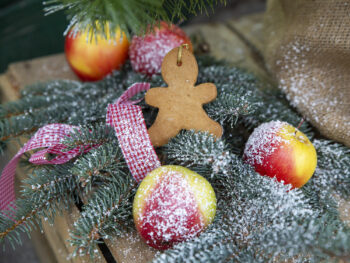Święta Bożego Narodzenia to wyjątkowy czas, na który wielu z nas czeka przez cały rok, a szczególnie dzieci. Oczywiście dla nich największym urokiem Świąt są prezenty, choinka i Mikołaj. Dorośli zaś bardziej skupiają się na przygotowaniach, przyrządzeniu odpowiednich potraw, wystroju mieszkania czy zachowaniu świątecznych zwyczajów, które znają ze swojego dzieciństwa. Które tradycje bożonarodzeniowe są wciąż najbardziej popularne w polskich domach, a które odeszły już w przeszłość? W tym artykule opowiadamy o najważniejszych z nich.
Wigilijne tradycje i symbole
Łamanie się opłatkiem
Wigilia jest kulminacyjnym punktem w obchodach Świąt Bożego Narodzenia i do tego dnia jest przypisanych najwięcej obrzędów i zwyczajów. Choć każda rodzina może mieć swoje własne przyzwyczajenia czy praktyki wigilijne np. związane z ubieraniem choinki czy rozdawaniem prezentów, to w polskiej tradycji najważniejsze tego wieczoru jest dzielenie się opłatkiem z najbliższymi i składanie sobie życzeń. Ten gest ma znaczenie symboliczne – służy wzajemnemu przebaczeniu i pojednaniu, czasami też poprzedza go modlitwa czy czytanie fragmentu z Ewangelii. Dopiero potem wszyscy zgromadzeni zasiadają do wigilijnej kolacji. Co więcej, musi być wtedy ciemno, gdy zaświeci już pierwsza gwiazdka na niebie.
Wigilijny stół i 12 potraw
Tradycyjny stół wigilijny jest przykryty białym obrusem, a pod nim włożone jest sianko, które symbolizuje ubóstwo, w jakim narodził się Jezus. W wielu domach wciąż kultywowany jest ten zwyczaj, jednak część osób odchodzi już od tego klasycznego podejścia i wybiera bardziej nowoczesne aranżacje na wigilijny stół.
Kolejnym ważnym polskim zwyczajem jest przygotowanie tradycyjnych, bezmięsnych potraw wigilijnych w liczbie co najmniej 12 – co w tym przypadku jest symbolem 12 apostołów, z którymi Jezus spożywał ostatnią wieczerzę. Ponadto według obyczaju każdego dania trzeba chociaż spróbować.
A które potrawy wigilijne najczęściej goszczą na naszych stołach? Z pewnością należą do nich barszcz czerwony z uszkami, karp, śledzie w różnych postaciach, pierogi z kapustą i grzybami, kompot z suszu, paszteciki, makaron z makiem, a także świąteczne ciasta.
Jeśli chodzi o wigilijny stół, to warto jeszcze wspomnieć o zwyczaju stawiania dodatkowego nakrycia. Jest to symboliczne miejsca dla przybysza, którego zaprasza się do wspólnej kolacji. Ten gest oznacza gościnność i otwartość domu na innych ludzi.
Ubieranie choinki
Trudno wyobrazić sobie Boże Narodzenie bez choinki, która jest obecna nie tylko w naszych domach, ale także w sklepach, szkołach czy urzędach. Zazwyczaj dekorujemy ją bombkami, łańcuchami i światełkami, ale w niektórych rodzinach panuje zwyczaj, aby samodzielnie wykonywać ozdoby z papieru i bibuły, jak również z pierników i owoców – tak jak to było w dawnych czasach.
W tradycji polskiej, jeszcze przed pojawieniem się klasycznej choinki bożonarodzeniowej, dekorowano pomieszczenia podłaźniczką, czyli uciętym wierzchołkiem świerka bądź sosny. Co więcej, wieszano ją pod sufitem do góry nogami, po wcześniejszym przyozdobieniu jabłkami, orzechami i innymi dekoracjami z bibuły czy słomy.
Prezenty pod choinką
Zwyczaj obdarowywania się upominkami jest nieodłącznym elementem Bożego Narodzenia – szczególnie oczekiwanym przez najmłodszych. W Polsce najbardziej rozpowszechnioną praktyką jest pozostawianie prezentów pod choinką, gdzie każdy znajduje upominek dla siebie. W większości domów paczki rozpakowuje się tego samego dnia, tuż po kolacji wigilijnej. Jeśli w rodzinie są małe dzieci, to zgodnie z przekazem rodziców prezenty przynosi Święty Mikołaj. Czasami robi to dopiero w nocy, więc w takiej sytuacji domownicy szukają upominków pod choinką w bożonarodzeniowy poranek.
Skąd pochodzi tradycja obdarowywania się prezentami w Boże Narodzenie? Ma ona związek z darami, które przynieśli dla Jezusa Mędrcy ze Wschodu. Dlatego też w niektórych krajach dzieci dostają prezenty dopiero 6 stycznia, czyli w święto Trzech Króli.
Dawne polskie zwyczaje bożonarodzeniowe
Poza opisanymi powyżej tradycjami, wciąż kultywowanymi w większości polskich domów, istnieje wiele zwyczajów, który zostały już zapomniane. Najczęściej były to ludowe obrzędy, praktykowane głównie na wsiach. Do dziś znane jest powiedzenie, że w noc wigilijną zwierzęta potrafią mówić ludzkim głosem. Jednak według dawnych obyczajów były to gospodarskie zwierzęta, które w tamtym czasie karmiono pozostałościami z kolacji wraz z pokruszonym opłatkiem.
Dawniej ludzie przywiązywali dużą wagę do tego, co się wydarzy w dzień wigilijny. W swoim zachowaniu kierowali się przysłowiem – „Jaka Wigilia, taki cały rok”. Dlatego od rana starano się zapewnić sobie i swojemu domowi pomyślność. Dzieci zaś napominano, aby były grzeczne, co też miało im posłużyć na cały rok. Istotne również było, kto pierwszy odwiedzi chatę w Wigilię – mężczyzna czy kobieta. Jeśli zrobił to mężczyzna, była to pozytywna wróżba, jeśli kobieta, to niestety nie.
Bardzo popularny był też, znany do dzisiaj, zwyczaj kolędowania. Choć obecnie ma on już inny wymiar niż kiedyś. Tuż po Bożym Narodzeniu wędrowała po wsi grupa kolędników, którzy byli poprzebierani za różne postacie np. zwierząt, królów czy aniołów. Szli z gwiazdą betlejemską, głową turonia albo innymi maszkarami. Zachodzili do domów, śpiewali, odgrywali scenki bożonarodzeniowe, składali życzenia gospodarzom, a w zamian prosili o datek, czyli właśnie o kolędę. Najczęściej otrzymywali drobne pieniądze i świąteczne jedzenie.
Z okazji zbliżających się Świąt Bożego Narodzenia w imieniu całego naszego zespołu Cukierni Jacek Placek pragniemy Wam złożyć serdeczne życzenia: zdrowia, szczęścia, pokoju, radości ze spotkań z bliskimi, pięknej choinki i wymarzonych prezentów! A ponadto jak najsmaczniejszych wypieków na świątecznym stole! Wesołych Świąt!




